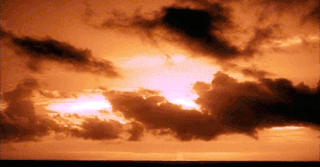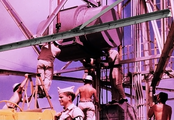
Nuclear weapon designs are physical, chemical, and engineering arrangements that cause the physics package of a nuclear weapon to detonate. There are three existing basic design types:

Operation Ivy was the eighth series of American nuclear tests, coming after Tumbler-Snapper and before Upshot–Knothole. The two explosions were staged in late 1952 at Enewetak Atoll in the Pacific Proving Ground in the Marshall Islands.

Operation Castle was a United States series of high-yield (high-energy) nuclear tests by Joint Task Force 7 (JTF-7) at Bikini Atoll beginning in March 1954. It followed Operation Upshot–Knothole and preceded Operation Teapot.

Operation Upshot–Knothole was a series of eleven nuclear test shots conducted in 1953 at the Nevada Test Site. It followed Operation Ivy and preceded Operation Castle.

Ivy King was the largest pure-fission nuclear bomb ever tested by the United States. The bomb was tested during the Truman administration as part of Operation Ivy. This series of tests involved the development of very powerful nuclear weapons in response to the nuclear weapons program of the Soviet Union.

Castle Bravo was the first in a series of high-yield thermonuclear weapon design tests conducted by the United States at Bikini Atoll, Marshall Islands, as part of Operation Castle. Detonated on March 1, 1954, the device remains the most powerful nuclear device ever detonated by the United States and the first lithium deuteride-fueled thermonuclear weapon tested using the Teller-Ulam design. Castle Bravo's yield was 15 megatonnes of TNT (63 PJ), 2.5 times the predicted 6 megatonnes of TNT (25 PJ), due to unforeseen additional reactions involving lithium-7, which led to radioactive contamination in the surrounding area.

Ivy Mike was the codename given to the first full-scale test of a thermonuclear device, in which part of the explosive yield comes from nuclear fusion. Ivy Mike was detonated on November 1, 1952, by the United States on the island of Elugelab in Enewetak Atoll, in the now independent island nation of the Marshall Islands, as part of Operation Ivy. It was the first full test of the Teller–Ulam design, a staged fusion device.
Variable yield, or dial-a-yield, is an option available on most modern nuclear weapons. It allows the operator to specify a weapon's yield, or explosive power, allowing a single design to be used in different situations. For example, the Mod-10 B61 bomb had selectable explosive yields of 0.3, 5, 10 or 80 kilotons, depending on how the ground crew set a dial inside the casing when it was loaded onto an aircraft.
Joe 4 was an American nickname for the first Soviet test of a thermonuclear weapon on August 12, 1953, that detonated with a force equivalent to 400 kilotons of TNT. The proper Soviet terminology for the warhead was RDS-6s, Reaktivnyi Dvigatel Specialnyi, lit. 'Special Jet Engine'.
RDS-37 was the Soviet Union's first two-stage hydrogen bomb, first tested on 22 November 1955. The weapon had a nominal yield of approximately 3 megatons. It was scaled down to 1.6 megatons for the live test.

A boosted fission weapon usually refers to a type of nuclear bomb that uses a small amount of fusion fuel to increase the rate, and thus yield, of a fission reaction. The neutrons released by the fusion reactions add to the neutrons released due to fission, allowing for more neutron-induced fission reactions to take place. The rate of fission is thereby greatly increased such that much more of the fissile material is able to undergo fission before the core explosively disassembles. The fusion process itself adds only a small amount of energy to the process, perhaps 1%.

Castle Romeo was the code name given to one of the tests in the Operation Castle series of U.S. nuclear tests. It was the first test of the TX-17 thermonuclear weapon, the first deployed thermonuclear bomb.

A thermonuclear weapon, fusion weapon or hydrogen bomb is a second-generation nuclear weapon design. Its greater sophistication affords it vastly greater destructive power than first-generation nuclear bombs, a more compact size, a lower mass, or a combination of these benefits. Characteristics of nuclear fusion reactions make possible the use of non-fissile depleted uranium as the weapon's main fuel, thus allowing more efficient use of scarce fissile material such as uranium-235 or plutonium-239. The first full-scale thermonuclear test was carried out by the United States in 1952; the concept has since been employed by most of the world's nuclear powers in the design of their weapons.
A pure fusion weapon is a hypothetical hydrogen bomb design that does not need a fission "primary" explosive to ignite the fusion of deuterium and tritium, two heavy isotopes of hydrogen used in fission-fusion thermonuclear weapons. Such a weapon would require no fissile material and would therefore be much easier to develop in secret than existing weapons. Separating weapons-grade uranium (U-235) or breeding plutonium (Pu-239) requires a substantial and difficult-to-conceal industrial investment, and blocking the sale and transfer of the needed machinery has been the primary mechanism to control nuclear proliferation to date.

The Mark 18 nuclear bomb, also known as the SOB or Super Oralloy Bomb, was an American nuclear bomb design which was the highest yield fission bomb produced by the US. The Mark 18 had a design yield of 500 kilotons. Nuclear weapon designer Ted Taylor was the lead designer for the Mark 18.

Greenhouse-Item was an American nuclear test conducted on May 25, 1951, as part of Operation Greenhouse at the Pacific Proving Ground, specifically on the island of Engebi in the Eniwetok Atoll in the Central Pacific Ocean. This test explosion was the first test of a boosted fission weapon.

Orange Herald was a British nuclear weapon, tested on 31 May 1957. At the time it was reported as an H-bomb, although in fact it was a large boosted fission weapon and remains to date, the largest fission device ever detonated.

Operation Redwing was a United States series of 17 nuclear test detonations from May to July 1956. They were conducted at Bikini and Enewetak atolls by Joint Task Force 7 (JTF7). The entire operation followed Project 56 and preceded Project 57. The primary intention was to test new, second-generation thermonuclear weapons. Also tested were fission devices intended to be used as primaries for thermonuclear weapons, and small tactical weapons for air defense. Redwing demonstrated the first United States airdrop of a deliverable hydrogen bomb during test Cherokee. Because the yields for many tests at Operation Castle in 1954 were dramatically higher than predictions, Redwing was conducted using an "energy budget": There were limits to the total amount of energy released, and the amount of fission yield was also strictly controlled. Fission, primarily "fast" fission of the natural uranium tamper surrounding the fusion capsule, greatly increases the yield of thermonuclear devices, and constitutes the great majority of the fallout, as nuclear fusion is a relatively clean reaction.

The uranium hydride bomb was a variant design of the atomic bomb first suggested by Robert Oppenheimer in 1939 and advocated and tested by Edward Teller. It used deuterium, an isotope of hydrogen, as a neutron moderator in a uranium-deuterium ceramic compact. Unlike all other fission-based weapon types, the concept relies on a chain reaction of slow nuclear fission. Bomb efficiency was adversely affected by the cooling of neutrons since the latter delays the reaction, as delineated by Rob Serber in his 1992 extension of the original Los Alamos Primer.

A fizzle occurs when the detonation of a device for creating a nuclear explosion grossly fails to meet its expected yield. The bombs still detonate, but the detonation is much less than anticipated. The cause(s) for the failure can be linked to improper design, poor construction, or lack of expertise. All countries that have had a nuclear weapons testing program have experienced some fizzles. A fizzle can spread radioactive material throughout the surrounding area, involve a partial fission reaction of the fissile material, or both. For practical purposes, a fizzle can still have considerable explosive yield when compared to conventional weapons.





















